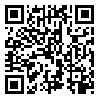دوره 5، شماره 1 - ( 12-1398 )
جلد 5 شماره 1 صفحات 33-27 |
برگشت به فهرست نسخه ها
چکیده: (2771 مشاهده)
Background and Aim: Temporomandibular disorder (TMD) is a multifactorial problem caused by many reasons. There is still controversy about the effect of different types of occlusal disorder on TMD. This study was designed to determine the effects of centric and assisted and unassisted non-working interferences on TMD.
Materials and Methods: In this cross-sectional study, 100 dental students, including 64 males and 36 females with the age range of 18 to 24 years old, were examined. Subjects with a history of systemic or muscular diseases and orthodontic treatment were excluded. TMD signs and symptoms including maximum mandibular opening limitation, maximum lateral movement limitation, maximum protrusion limitation, deviation and deflection, joint pain and tenderness, joint sounds, and masticatory muscle tenderness were examined. Subjects were also examined for having centric interferences and eccentric interferences including assisted and unassisted non-working interferences. Data were analyzed using the chi-square test and independent-sample T-test.
Results: Subjects with centric interference had a significantly higher number of clicks (P=0.02), medial pterygoid tenderness (P=0.009), and right medial pterygoid tenderness (P=0.007). We could also find a significantly higher number of clicking in subjects with assisted non-working interference (P=0.002).
Conclusion: The findings of the present study suggest that different types of occlusal interference, specially centric and assisted non-working interferences, can lead to TMD signs and symptoms.
Materials and Methods: In this cross-sectional study, 100 dental students, including 64 males and 36 females with the age range of 18 to 24 years old, were examined. Subjects with a history of systemic or muscular diseases and orthodontic treatment were excluded. TMD signs and symptoms including maximum mandibular opening limitation, maximum lateral movement limitation, maximum protrusion limitation, deviation and deflection, joint pain and tenderness, joint sounds, and masticatory muscle tenderness were examined. Subjects were also examined for having centric interferences and eccentric interferences including assisted and unassisted non-working interferences. Data were analyzed using the chi-square test and independent-sample T-test.
Results: Subjects with centric interference had a significantly higher number of clicks (P=0.02), medial pterygoid tenderness (P=0.009), and right medial pterygoid tenderness (P=0.007). We could also find a significantly higher number of clicking in subjects with assisted non-working interference (P=0.002).
Conclusion: The findings of the present study suggest that different types of occlusal interference, specially centric and assisted non-working interferences, can lead to TMD signs and symptoms.
نوع مطالعه: Original article |
موضوع مقاله:
Oral & maxillofacial surgery
| بازنشر اطلاعات | |
 |
این مقاله تحت شرایط Creative Commons Attribution-NonCommercial 4.0 International License قابل بازنشر است. |

